The graphs show my first data collection since the plumbing change. I started the Froling with the first wood load at about 6:30 am and staff at DP tended the boiler thereafter. During the entire operation shown, the following demands would have been active according to calls for heat: 1) three zones supplied by a single circ for two bedrooms plus a hallway; 2) two water to air coil units in the plenums of two LP furnaces (LP is “off”); and 3) a heliodyne solar water/water hx unit to charge a dhw tank. Each is served by separate 15-58 circs, 1) and 3) on Lo and 2) on Hi (2 circs). The boiler loading unit is an LK 810 with an integral 15-58 circ on Hi. These all are as originally installed.
In my own arrangement I wanted to prioritize cold start performance. With cold storage and the burner firing, heat to the load and not storage.
The second graph shows that boiler supply to the top of the tank does not result in the same hot temperature water to system supply. While the temperature of the tank top rises rapidly, As does system supply temperature, the system supply temperature remains less than the boiler supply temperature. It is apparent that some mixing is resulting as hot water is supplied to the tank and as system return water is injected into the middle of the tank, and stratification, while good, likely could be improved by a different plumbing design.
I was considering some way to have stratification and the weight of the tank water to work in auto, so when return comes back a lot warmer, the heavier colder water in the storage tank should now prioritize loading into storage.
I’m not sure of the physics of your operational theory. Pressure is equal throughout the system. While stratification depends on density, I don’t think that somehow the weight of the water provides an “auto” operation, other than enhancing the stratification process.
In diagram A, the return riser going up creates a heat trap (trapping the cold lower), so in reverse flow when the boiler is firing and loading the storage, the colder water has to first rise then fall into the boiler, prioritizing the other path, the warmer return water has the easier job of just falling into the boiler.
For me this relates to the extent of mixing and impact on stratification during a load or discharge process.
Returning of the warmer return water to the middle of the tank is a keen insight.
Thank you, but there have been a number of posts dealing with improved methods of handling warm return water to maximize stratifcation and to make the hottest water always available to the system and the coldest water available to the boiler return to maximize delta-T and boiler hx performance. Ideally, warm system return water would be injected into the tank at various points, depending on the temperature of the return water and the temperature of the stratified tank water. Injection at a mid-point seemed to make the most sense in the DP application and multiple injection points involve more complicated controls and plumbing.
Some other initial observations, and analysis by others is welcome.
1) The first graph shows pretty good stratification occurring within the tank. The objective of making sure that coldest water was available to boiler return has been substantially achieved, while also achieving the objective of making hot water available to the system.
2) During the period of operation covered by the graph, outside temperatures ranged between about 28-40F. I know that the Froling was not being loaded with wood to achieve maximum output. My first wood load was about a 2/3 loading of the firebox, and I have good reason to assume that subsequent loading were likely to somewhat less than ½ of the firebox. Even with this loading the Froling easily handled all system demands and continued to charge the tank. The building being served is 6000 sq feet, 3 levels, and is a 1970's building, poorly insulated.
3) I’m not sure what is occurring during the two sharp downward spikes and quick recovery of the boiler supply temperatures. My initial thought is that some bridging might be occurring in the Froling burn process.
4) The graph does not provide data to indicate whether or not any idling occurred during the burn process. I was present during the first 1-2 hours of operation, boiler supply temperature was relatively constant, the induced draft fan was in continuous operation, was not noticeably modulating, and no idling was occurring during that time. At a later point I will add a sensor to monitor and log flue temperature, and that may provide more useful data to show the operational characteristics of the Froling, including idle periods which I think should be evidence by episodes of reduced flue temperature.
5) When weather gets much colder and the Froling can be pushed for maximum output over an extended period of time, I will do weighed wood burns and better assess the Froling performance.
6) The Froling is attended largely by inexperienced staff. I am working on wood loading instructions to make it easy for staff to not overload the Froling and cause idling when the tank does not have capacity to absorb the btu’s generated by the wood load. The Froling control has a sensor at about the tank mid-point which shows on the control display. Right now this will be used to indicate when and how much wood should be loaded.
7) I will be adding a display panel with digital panel meters to make it very easy to monitor various aspects of the Froling operation, much like I have done with the Wood Gun E500 and the Garn WHS3200 also in operation at DP and serving the main structures.


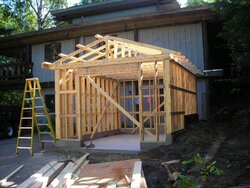
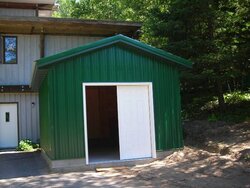
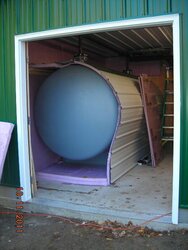
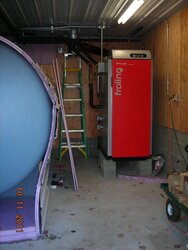
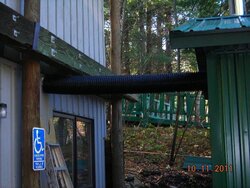
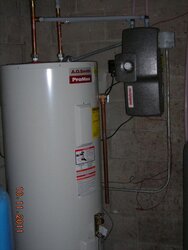
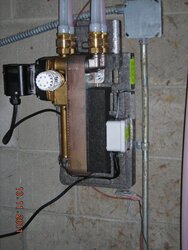
 -T may end up in the vicinity of 20F +/-. At that temperature difference, and assuming 12 gpm from the loading unit, only 120,000 btuh can be moved from the boiler, which is well below the Froling capacity.
-T may end up in the vicinity of 20F +/-. At that temperature difference, and assuming 12 gpm from the loading unit, only 120,000 btuh can be moved from the boiler, which is well below the Froling capacity.  Jim, I wonder if you might want to get Fröling's "Vision" software that would allow you to easily monitor and data log most everything you are interested in and view it / save it onto an SD card or a laptop? Also, you may want to consider adding our Acaso Automix outdoor reset control. This time of year especially, you will just be sipping off the tank which will maintain better stratification and the lower return temps you are looking for. One last thing, I am reminded of Piker's install where he was seeing higher than expected/desired return temps - turns out the loading unit pump was moving water too QUICKLY. So what was happening was that a well defined stream developed in the tank where water was flowing from the supply straight to the return which was screwing up stratification and not doing much mixing either. I'm not sure that is what is going on here, but it might be worth trying turning the loading unit down a speed. Looking forward to hearing more. Chris
Jim, I wonder if you might want to get Fröling's "Vision" software that would allow you to easily monitor and data log most everything you are interested in and view it / save it onto an SD card or a laptop? Also, you may want to consider adding our Acaso Automix outdoor reset control. This time of year especially, you will just be sipping off the tank which will maintain better stratification and the lower return temps you are looking for. One last thing, I am reminded of Piker's install where he was seeing higher than expected/desired return temps - turns out the loading unit pump was moving water too QUICKLY. So what was happening was that a well defined stream developed in the tank where water was flowing from the supply straight to the return which was screwing up stratification and not doing much mixing either. I'm not sure that is what is going on here, but it might be worth trying turning the loading unit down a speed. Looking forward to hearing more. Chris